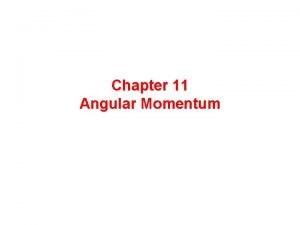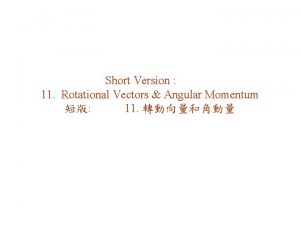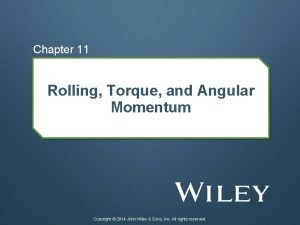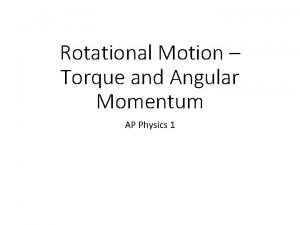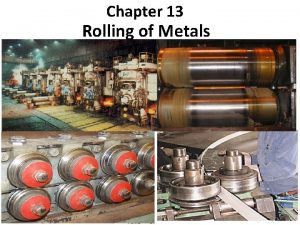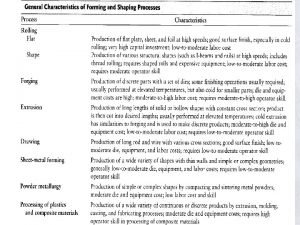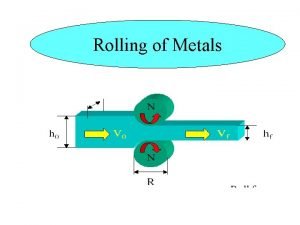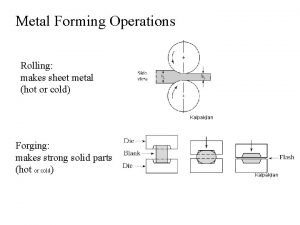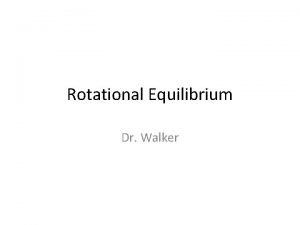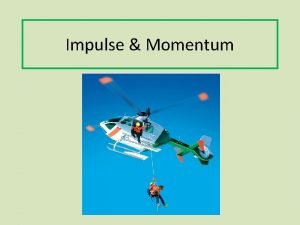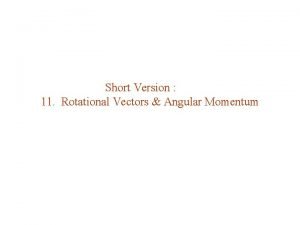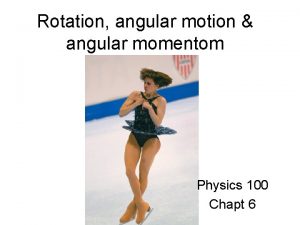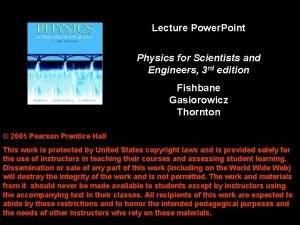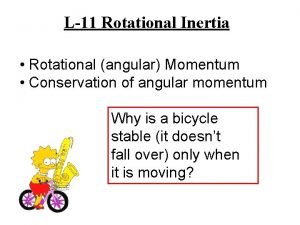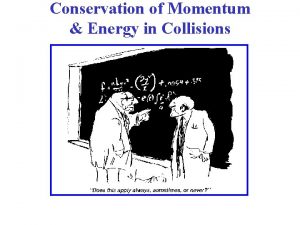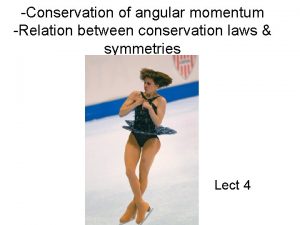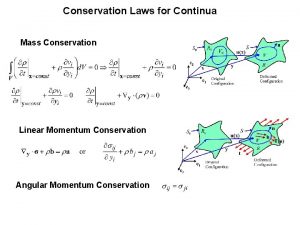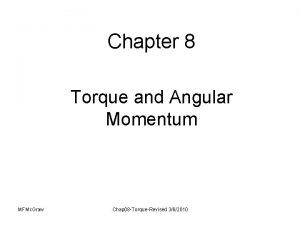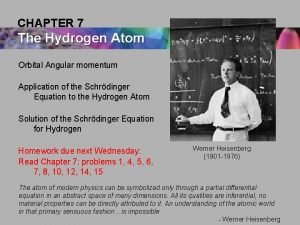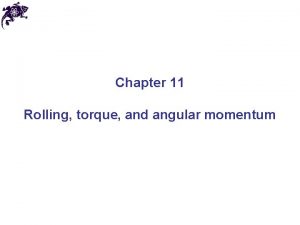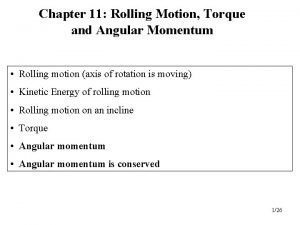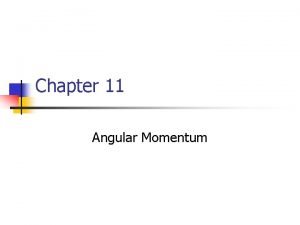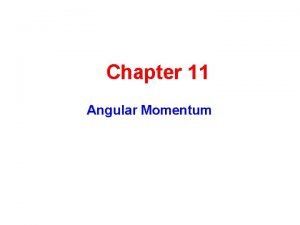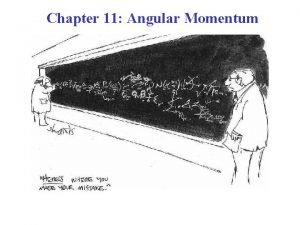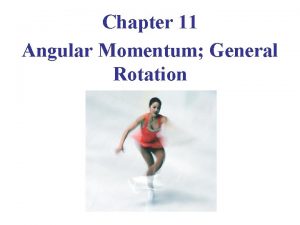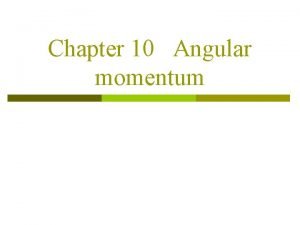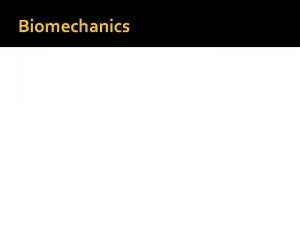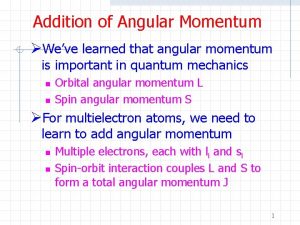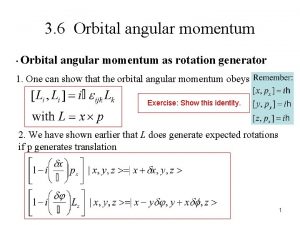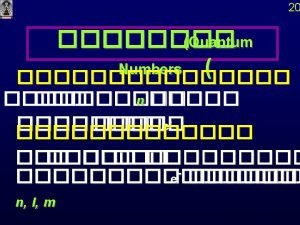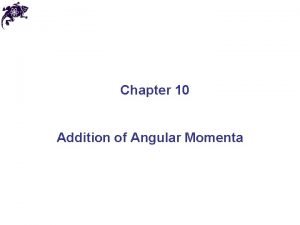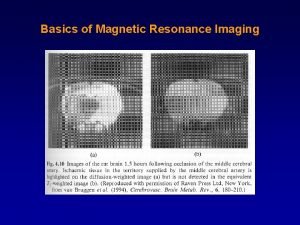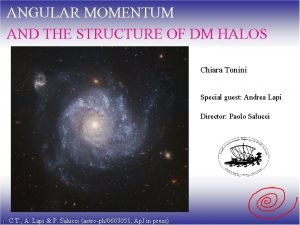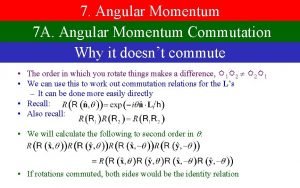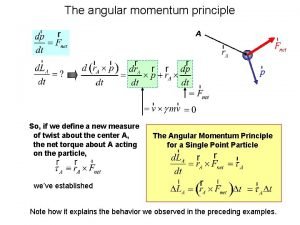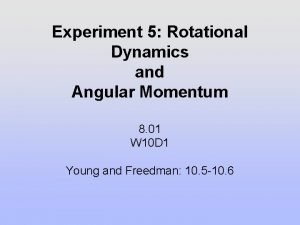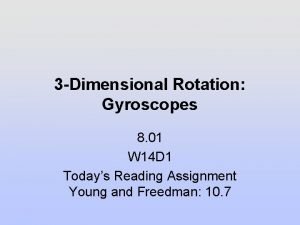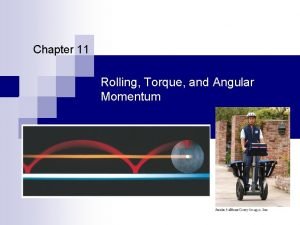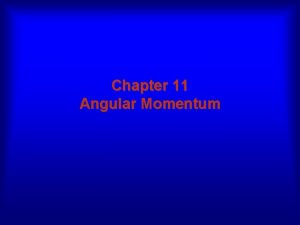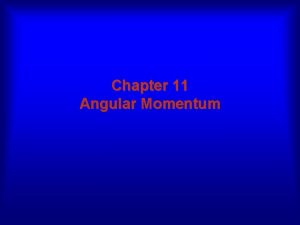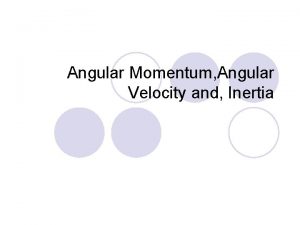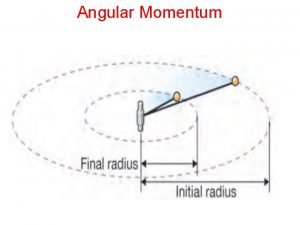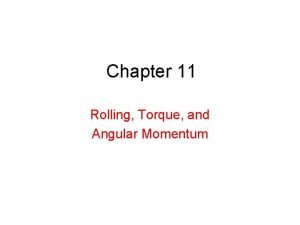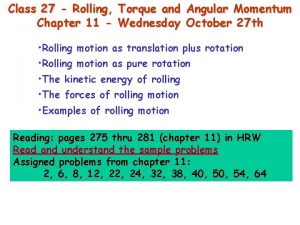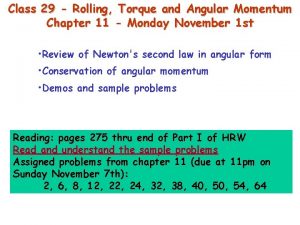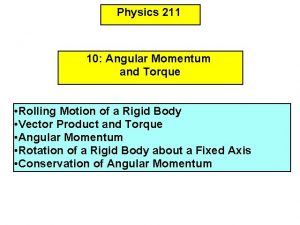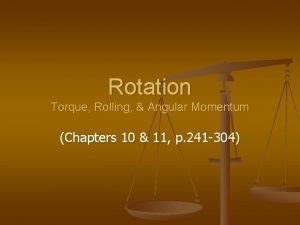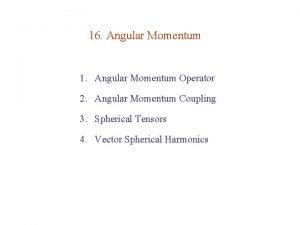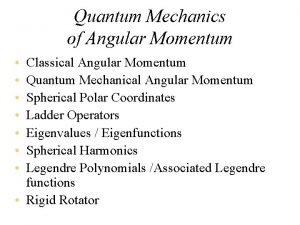Chapter 11 Rolling Torque and Angular Momentum Copyright








































- Slides: 40

Chapter 11 Rolling, Torque, and Angular Momentum Copyright © 2014 John Wiley & Sons, Inc. All rights reserved.

11 -1 Rolling as Translation and Rotation Combined Learning Objectives 11. 01 Identify that smooth rolling can be considered as a combination of pure translation and pure rotation. 11. 02 Apply the relationship between the center-of-mass speed and the angular speed of a body in smooth rolling. © 2014 John Wiley & Sons, Inc. All rights reserved. Figure 11 -2

11 -1 Rolling as Translation and Rotation Combined We consider only objects that roll smoothly (no slip) The center of mass (com) of the object moves in a straight line parallel to the surface The object rotates around the com as it moves The rotational motion is defined by: Eq. (11 -1) Eq. (11 -2) © 2014 John Wiley & Sons, Inc. All rights reserved. Figure 11 -3

11 -1 Rolling as Translation and Rotation Combined Figure 11 -4 The figure shows how the velocities of translation and rotation combine at different points on the wheel Answer: (a) the same (b) less than © 2014 John Wiley & Sons, Inc. All rights reserved.

11 -2 Forces and Kinetic Energy of Rolling Learning Objectives 11. 03 Calculate the kinetic energy of a body in smooth rolling as the sum of the translational kinetic energy of the center of mass and the rotational kinetic energy around the center of mass. 11. 04 Apply the relationship between the work done on a smoothly rolling object and its kinetic energy change. initial energy values to the values at a later point. 11. 06 Draw a free-body diagram of an accelerating body that is smoothly rolling on a horizontal surface or up or down on a ramp. 11. 05 For smooth rolling (and thus no sliding), conserve mechanical energy to relate © 2014 John Wiley & Sons, Inc. All rights reserved.

11 -2 Forces and Kinetic Energy of Rolling 11. 07 Apply the relationship between the center-of-mass acceleration and the angular acceleration. 11. 08 For smooth rolling up or down a ramp, apply the relationship between the object’s acceleration, its rotational inertia, and the angle of the ramp. © 2014 John Wiley & Sons, Inc. All rights reserved.

11 -2 Forces and Kinetic Energy of Rolling Combine translational and rotational kinetic energy: Eq. (11 -5) If a wheel accelerates, its angular speed changes A force must act to prevent slip Eq. (11 -6) Figure 11 -7 © 2014 John Wiley & Sons, Inc. All rights reserved.

11 -2 Forces and Kinetic Energy of Rolling If slip occurs, then the motion is not smooth rolling! For smooth rolling down a ramp: 1. The gravitational force is vertically down 2. The normal force is perpendicular to the ramp 3. The force of friction points up the slope Figure 11 -8 © 2014 John Wiley & Sons, Inc. All rights reserved.

11 -2 Forces and Kinetic Energy of Rolling We can use this equation to find the acceleration of such a body Eq. (11 -10) Note that the frictional force produces the rotation Without friction, the object will simply slide Answer: The maximum height reached by B is less than that reached by A. For A, all the kinetic energy becomes potential energy at h. Since the ramp is frictionless for B, all of the rotational K stays rotational, and only the translational kinetic energy becomes potential energy at its maximum height. © 2014 John Wiley & Sons, Inc. All rights reserved.

11 -3 The Yo-Yo Learning Objectives 11. 09 Draw a free-body diagram of a yo-yo moving up or down its string. 11. 10 Identify that a yo-yo is effectively an object that rolls smoothly up or down a ramp with an incline angle of 90°. 11. 11 For a yo-yo moving up or down its string, apply the relationship between the yoyo's acceleration and its rotational inertia. 11. 12 Determine the tension in a yo-yo's string as the yo-yo moves up or down the string. © 2014 John Wiley & Sons, Inc. All rights reserved.

11 -3 The Yo-Yo As a yo-yo moves down a string, it loses potential energy mgh but gains rotational and translational kinetic energy To find the linear acceleration of a yo-yo accelerating down its string: 1. Rolls down a “ramp” of angle 90° 2. Rolls on an axle instead of its outer surface 3. Slowed by tension T rather than friction Figure 11 -9 © 2014 John Wiley & Sons, Inc. All rights reserved.

11 -3 The Yo-Yo Replacing the values in 11 -10 leads us to: Eq. (11 -13) Example Calculate the acceleration of the yo-yo o o M = 150 grams, R 0 = 3 mm, Icom = Mr 2/2 = 3 E-5 kg m 2 Therefore acom = -9. 8 m/s 2 / (1 + 3 E-5 / (0. 15 * 0. 0032)) = -. 4 m/s 2 © 2014 John Wiley & Sons, Inc. All rights reserved.

11 -4 Torque Revisited Learning Objectives 11. 13 Identify that torque is a vector quantity. 11. 14 Identify that the point about which a torque is calculated must always be specified. 11. 16 Use the right-hand rule for cross products to find the direction of a torque vector. 11. 15 Calculate the torque due to a force on a particle by taking the cross product of the particle's position vector and the force vector, in either unit-vector notation or magnitude-angle notation. © 2014 John Wiley & Sons, Inc. All rights reserved.

11 -4 Torque Revisited Previously, torque was defined only for a rotating body and a fixed axis Now we redefine it for an individual particle that moves along any path relative to a fixed point The path need not be a circle; torque is now a vector Direction determined with right-hand-rule Figure 11 -10 © 2014 John Wiley & Sons, Inc. All rights reserved.

11 -4 Torque Revisited The general equation for torque is: Eq. (11 -14) We can also write the magnitude as: Eq. (11 -15) Or, using the perpendicular component of force or the moment arm of F: Eq. (11 -16) Eq. (11 -17) © 2014 John Wiley & Sons, Inc. All rights reserved.

11 -4 Torque Revisited Answer: (a) along the z direction (b) along the +y direction (c) along the +x direction © 2014 John Wiley & Sons, Inc. All rights reserved.

11 -4 Torque Revisited Example Calculating net torque: Figure 11 -11 © 2014 John Wiley & Sons, Inc. All rights reserved.

11 -5 Angular Momentum Learning Objectives 11. 17 Identify that angular momentum is a vector quantity. 11. 18 Identify that the fixed point about which an angular momentum is calculated must always be specified. or magnitude-angle notation. 11. 20 Use the right-hand rule for cross products to find the direction of an angular momentum vector. 11. 19 Calculate the angular momentum of a particle by taking the cross product of the particle's position vector and its momentum vector, in either unit-vector notation © 2014 John Wiley & Sons, Inc. All rights reserved.

11 -5 Angular Momentum Here we investigate the angular counterpart to linear momentum We write: Eq. (11 -18) Note that the particle need not rotate around O to have angular momentum around it The unit of angular momentum is kg m 2/s, or J s Figure 11 -12 © 2014 John Wiley & Sons, Inc. All rights reserved.

11 -5 Angular Momentum To find the direction of angular momentum, use the right-hand rule to relate r and v to the result To find the magnitude, use the equation for the magnitude of a cross product: Eq. (11 -19) Which can also be written as: Eq. (11 -20) Eq. (11 -21) © 2014 John Wiley & Sons, Inc. All rights reserved.

11 -5 Angular Momentum Angular momentum has meaning only with respect to a specified origin It is always perpendicular to the plane formed by the position and linear momentum vectors Answer: (a) 1 & 3, 2 & 4, 5 (b) 2 and 3 (assuming counterclockwise is positive) © 2014 John Wiley & Sons, Inc. All rights reserved.

11 -6 Newton's Second Law in Angular Form Learning Objectives 11. 21 Apply Newton's second law in angular form to relate the torque acting on a particle to the resulting rate of change of the particle's angular momentum, all relative to a specified point. © 2014 John Wiley & Sons, Inc. All rights reserved.

11 -6 Newton's Second Law in Angular Form We rewrite Newton's second law as: Eq. (11 -23) The torque and the angular momentum must be defined with respect to the same point (usually the origin) Note the similarity to the linear form: Eq. (11 -22) © 2014 John Wiley & Sons, Inc. All rights reserved.

11 -6 Newton's Second Law in Angular Form Answer: (a) F 3, F 1, F 2 & F 4 (b) F 3 (assuming counterclockwise is positive) © 2014 John Wiley & Sons, Inc. All rights reserved.

11 -7 Angular Momentum of a Rigid Body Learning Objectives 11. 22 For a system of particles, apply Newton's second law in angular form to relate the net torque acting on the system to the rate of the resulting change in the system's angular momentum. 11. 23 Apply the relationship between the angular momentum of a rigid body rotating around a fixed axis and the body's rotational inertia and angular speed around that axis. 11. 24 If two rigid bodies rotate about the same axis, calculate their total angular momentum. © 2014 John Wiley & Sons, Inc. All rights reserved.

11 -7 Angular Momentum of a Rigid Body We sum the angular momenta of the particles to find the angular momentum of a system of particles: Eq. (11 -26) The rate of change of the net angular momentum is: Eq. (11 -28) In other words, the net torque is defined by this change: Eq. (11 -29) © 2014 John Wiley & Sons, Inc. All rights reserved.

11 -7 Angular Momentum of a Rigid Body Note that the torque and angular momentum must be measured relative to the same origin If the center of mass is accelerating, then that origin must be the center of mass We can find the angular momentum of a rigid body through summation: Eq. (11 -30) The sum is the rotational inertia I of the body © 2014 John Wiley & Sons, Inc. All rights reserved.

11 -7 Angular Momentum of a Rigid Body Therefore this simplifies to: Eq. (11 -31) Table 11 -1 © 2014 John Wiley & Sons, Inc. All rights reserved. Figure 11 -15

11 -7 Angular Momentum of a Rigid Body Answer: (a) All angular momenta will be the same, because the torque is the same in each case (b) sphere, disk, hoop © 2014 John Wiley & Sons, Inc. All rights reserved.

11 -8 Conservation of Angular Momentum Learning Objectives 11. 25 When no external net torque acts on a system along a specified axis, apply the conservation of angular momentum to relate the initial angular momentum value along that axis to the value at a later instant. © 2014 John Wiley & Sons, Inc. All rights reserved.

11 -8 Conservation of Angular Momentum Since we have a new version of Newton's second law, we also have a new conservation law: Eq. (11 -32) The law of conservation of angular momentum states that, for an isolated system, (net initial angular momentum) = (net final angular momentum) Eq. (11 -33) © 2014 John Wiley & Sons, Inc. All rights reserved.

11 -8 Conservation of Angular Momentum Since these are vector equations, they are equivalent to the three corresponding scalar equations This means we can separate axes and write: If the distribution of mass changes with no external torque, we have: Eq. (11 -34) © 2014 John Wiley & Sons, Inc. All rights reserved.

11 -8 Conservation of Angular Momentum Example Angular momentum conservation A student spinning on a stool: rotation speeds up when arms are brought in, slows down when arms are extended A springboard diver: rotational speed is controlled by tucking her arms and legs in, which reduces rotational inertia and increases rotational speed A long jumper: the angular momentum caused by the torque during the initial jump can be transferred to the rotation of the arms, by windmilling them, keeping the jumper upright Figure 11 -18 © 2014 John Wiley & Sons, Inc. All rights reserved.

11 -8 Conservation of Angular Momentum Answer: (a) decreases (b) remains the same (c) increases © 2014 John Wiley & Sons, Inc. All rights reserved.

11 -9 Precession of a Gyroscope Learning Objectives 11. 26 Identify that the gravitational force acting on a spinning gyroscope causes the spin angular momentum vector (and thus the gyroscope) to rotate about the vertical axis in a motion called precession. 11. 27 Calculate the precession rate of a gyroscope. 11. 28 Identify that a gyroscope's precession rate is independent of the gyroscope's mass. © 2014 John Wiley & Sons, Inc. All rights reserved.

11 -9 Precession of a Gyroscope A nonspinning gyroscope, as attached in 11 -22 (a), falls A spinning gyroscope (b) instead rotates around a vertical axis This rotation is called precession Figure 11 -22 © 2014 John Wiley & Sons, Inc. All rights reserved.

11 -9 Precession of a Gyroscope The angular momentum of a (rapidly spinning) gyroscope is: Eq. (11 -43) The torque can only change the direction of L, not its magnitude, because of (11 -43) Eq. (11 -44) The only way its direction can change along the direction of the torque without its magnitude changing is if it rotates around the central axis Therefore it precesses instead of toppling over © 2014 John Wiley & Sons, Inc. All rights reserved.

11 -9 Precession of a Gyroscope The precession rate is given by: Eq. (11 -46) True for a sufficiently rapid spin rate Independent of mass, (I is proportional to M) but does depend on g Valid for a gyroscope at an angle to the horizontal as well (a top for instance) © 2014 John Wiley & Sons, Inc. All rights reserved.

11 Summary Rolling Bodies Torque as a Vector Eq. (11 -2) Direction given by the righthand rule Eq. (11 -5) Eq. (11 -14) Eq. (11 -6) Angular Momentum of a Particle Newton's Second Law in Angular Form Eq. (11 -23) Eq. (11 -18) © 2014 John Wiley & Sons, Inc. All rights reserved.

11 Summary Angular Momentum of a System of Particles Angular Momentum of a Rigid Body Eq. (11 -31) Eq. (11 -26) Eq. (11 -29) Conservation of Angular Momentum Precession of a Gyroscope Eq. (11 -32) Eq. (11 -33) © 2014 John Wiley & Sons, Inc. All rights reserved. Eq. (11 -46)
 Rolling torque and angular momentum
Rolling torque and angular momentum Rolling torque and angular momentum
Rolling torque and angular momentum Rolling torque and angular momentum
Rolling torque and angular momentum Torque and angular momentum
Torque and angular momentum Angular momentum theorem
Angular momentum theorem Difference between flat rolling and shape rolling
Difference between flat rolling and shape rolling Difference between flat rolling and shape rolling
Difference between flat rolling and shape rolling Flat rolling
Flat rolling Hot rolling and cold rolling
Hot rolling and cold rolling Hot rolling vs cold rolling
Hot rolling vs cold rolling Skater angular momentum
Skater angular momentum Conceptual physics chapter 6 momentum
Conceptual physics chapter 6 momentum Principle of angular impulse and momentum
Principle of angular impulse and momentum Conservation of angular momentum
Conservation of angular momentum Angular quantities
Angular quantities Torque direction right hand rule
Torque direction right hand rule Angular velocity and inertia
Angular velocity and inertia In an inelastic collision what is conserved
In an inelastic collision what is conserved Law of conservation of angular momentum
Law of conservation of angular momentum Conservation of linear momentum
Conservation of linear momentum Angular momentum right hand rule
Angular momentum right hand rule Angular momentum quantum number
Angular momentum quantum number Angular momentum in classical mechanics
Angular momentum in classical mechanics Angular momentum rigid body
Angular momentum rigid body Si unit of angular momentum
Si unit of angular momentum Momentum in si units
Momentum in si units The angular momentum is
The angular momentum is Angular momentum units
Angular momentum units Whats angular momentum
Whats angular momentum Angular momentum
Angular momentum Angular momentum biomechanics
Angular momentum biomechanics Orbital angular momentum quantum number
Orbital angular momentum quantum number Angular momentum in orbit
Angular momentum in orbit Angular momentum quantum number
Angular momentum quantum number Addition of three angular momenta
Addition of three angular momenta Angular momentum mri
Angular momentum mri Quantum angular momentum toy
Quantum angular momentum toy Commutator angular momentum
Commutator angular momentum Angular momentum
Angular momentum Linear momentum in circular motion
Linear momentum in circular motion Flywheel angular momentum
Flywheel angular momentum
